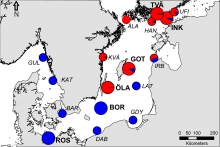Momigliano P., Denys G.P.J., Jokinen H., Merilä J., 2018. Platichthys solemdali sp. nov. (Actinopterygii, Pleuronectiformes): a new flounder species from the Baltic Sea. Frontiers in Marine Science, 5, 225. doi: 10.3389/fmars.2018.00225
The European flounder Platichthys flesus (Linnaeus, 1758) displays two contrasting reproductive behaviors in the Baltic Sea: offshore spawning of pelagic eggs and coastal spawning of demersal eggs, a behavior observed exclusively in the Baltic Sea. Previous studies showed marked differences in behavioral, physiological, and life-history traits of flounders with pelagic and demersal eggs. Furthermore, a recent study demonstrated that flounders with pelagic and demersal eggs represent two reproductively isolated, parapatric species arising from two distinct colonization events from the same ancestral population. Using morphological data we first established that the syntypes on which the original description of P. flesus was based belong to the pelagic-spawning lineage. We then used a combination of morphological and physiological characters as well as genome-wide genetic data to describe flounders with demersal eggs as a new species: Platichthys solemdali sp. nov. The new species can be clearly distinguished from P. flesus based on egg morphology, egg and sperm physiology as well as via population genetic and phylogenetic analyses. While the two species do show some minor morphological differences in the number of anal and dorsal fin rays, no external morphological feature can be used to unambiguously identify individuals to species. Therefore, we developed a simple molecular diagnostic test able to unambiguously distinguish P. solemdali from P. flesus with a single PCR reaction, a tool that should be useful to fishery scientists and managers, as well as to ecologists studying these species.
BOREA contact: Gaël Denys, gael.denys@mnhn.fr


